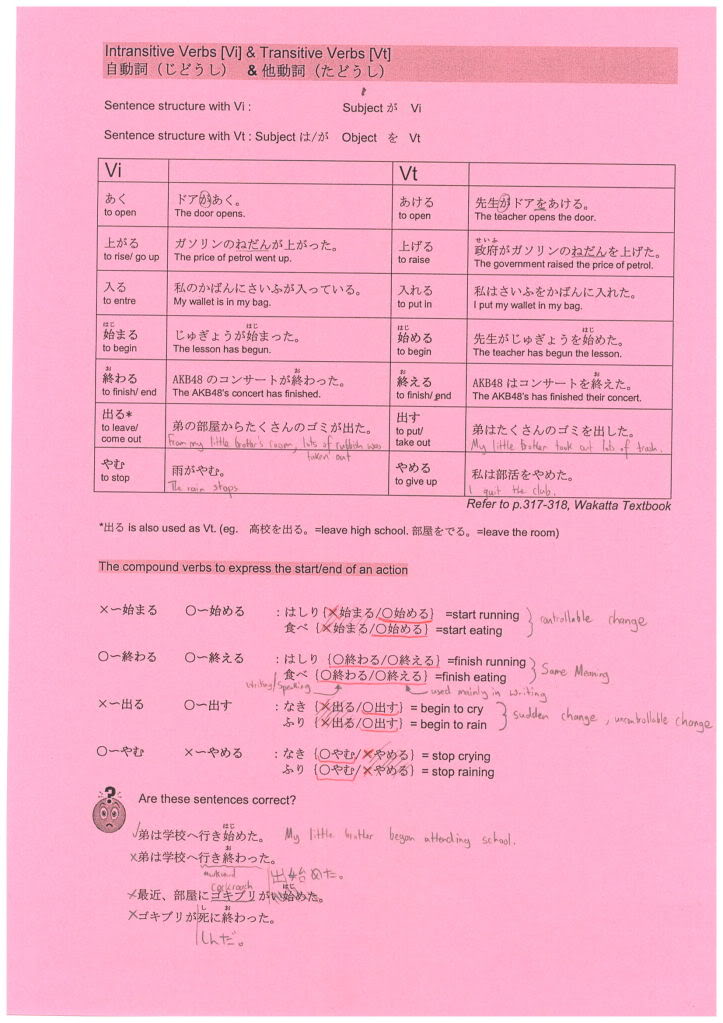I know speak japanese too.count me in .smile.
日本語教室 - Nihongo Kyoushitsu [Page 3 of 9]
Re: 日本語教室 - Nihongo Kyoushitsu
Posted Fri Feb 18, 2011 6:02 am
Hey, do you think you could explain a bit on intransitive and transitive verbs?
I keep getting mixed up between them.
eg:
終る is the intransitive verb
and 終える is the transitive verb
How does the meaning change when using each verb?
Also, is there a pattern or an easy way of remembering/identifying intransitive/transitive forms of each verb.
I keep getting mixed up between them.
eg:
終る is the intransitive verb
and 終える is the transitive verb
How does the meaning change when using each verb?
Also, is there a pattern or an easy way of remembering/identifying intransitive/transitive forms of each verb.
Re: 日本語教室 - Nihongo Kyoushitsu
Posted Sat Feb 19, 2011 6:19 am
tenjounokaze
Indie Artist
Jibba wrote:Hey, do you think you could explain a bit on intransitive and transitive verbs?
I keep getting mixed up between them.
eg:
終る is the intransitive verb
and 終える is the transitive verb
How does the meaning change when using each verb?
Also, is there a pattern or an easy way of remembering/identifying intransitive/transitive forms of each verb.
Jibba, the basic rule is that Transitive verbs require an object, while Intransitive verbs do not. For example:
"The teacher began class" - > 先生が授業を始めた (in this case, class is the object, marked by the direct object marker を, and accompanied by the transitive verb 始める "to begin")
"Class began" - > 授業が始まった (in this case, class becomes the subject, marked by the subject marker が, and accompanied by the intransitive verb 始まる "to begin")
In the first sentence, the teacher is emphasized, since he/she took the action to start the class. However, in the second sentence, the teacher is not mentioned, and thus the fact that class has simply started is the subject (Notice the subject marker が has shifted from the teacher to class).
So, if you want to include the fact/information that the teacher started the class, or if you are trying to explain/emphasize that in a sentence, you would use a Transitive verb. If you do not need emphasis on the teacher, or if you just don't need to/want to mention the teacher, you can just use an Intransitive verb.
As for the pattern/way of remembering, a lot of the transitive/intransitive pairs have an え in the transitive that is replaced by a わ in the intransitive, such as the following pairs: 伝える・伝わる(Tsutaeru/Tsutawaru - to get across/convey)、終える・終わる(Oeru/Owaru - to end)、変える・変わる (Kaeru/Kawaru - to change)、and others. However, there are other pairs where this is not the case: 減らす・減る(Herasu/Heru - to decrease)、増やす・増える(Fuyasu/Fueru - to increase)、続ける・続く(Tsuzukeru/Tsuzuku - to continue), and so, the best and most reliable way to tell if a verb is Transitive or Intransitive is to look at the particle in front of it - if you see an を, it is Transitive; if you see a が, it is Intransitive.
Thanks for your question! .balloon.
独りきりなんて、人生勿体無い
Life's a waste if you're all alone. (SCANDAL, Everybody Say YEAH)

Need help with Japanese? - Be sure to visit my Japanese thread: Class is now in session!
Life's a waste if you're all alone. (SCANDAL, Everybody Say YEAH)

Need help with Japanese? - Be sure to visit my Japanese thread: Class is now in session!
Re: 日本語教室 - Nihongo Kyoushitsu
Posted Sat Feb 19, 2011 7:17 am
 Thanks so much for the comprehensive answer!
Thanks so much for the comprehensive answer!I understand it much better now.
I found a pretty useful site on the transitive/intransitive pairs, from the uni I may go to next year.
http://www.csse.monash.edu.au/~jwb/ti_list.html
It has a comprehensive list of the patterns and pairs.
Re: 日本語教室 - Nihongo Kyoushitsu
Posted Tue Feb 22, 2011 6:07 pm
320x200
Mainstream Artist
Mini-question 
What does "なう" mean? Google translate always just translates it as "nau", which isn't really a word in english. An example of it is in a recent tweet by Rina: "クッキングなう。" It sounds like "now", which could make sense in Rina's tweet, but it's written in hiragana so I dunno about guessing just based on sound and that doesn't seem like the right word order...
An example of it is in a recent tweet by Rina: "クッキングなう。" It sounds like "now", which could make sense in Rina's tweet, but it's written in hiragana so I dunno about guessing just based on sound and that doesn't seem like the right word order...

What does "なう" mean? Google translate always just translates it as "nau", which isn't really a word in english.
 An example of it is in a recent tweet by Rina: "クッキングなう。" It sounds like "now", which could make sense in Rina's tweet, but it's written in hiragana so I dunno about guessing just based on sound and that doesn't seem like the right word order...
An example of it is in a recent tweet by Rina: "クッキングなう。" It sounds like "now", which could make sense in Rina's tweet, but it's written in hiragana so I dunno about guessing just based on sound and that doesn't seem like the right word order... Re: 日本語教室 - Nihongo Kyoushitsu
Posted Tue Feb 22, 2011 9:22 pm
tenjounokaze
Indie Artist
320x200 wrote:Mini-question
What does "なう" mean? Google translate always just translates it as "nau", which isn't really a word in english.An example of it is in a recent tweet by Rina: "クッキングなう。" It sounds like "now", which could make sense in Rina's tweet, but it's written in hiragana so I dunno about guessing just based on sound and that doesn't seem like the right word order...
This is something that I ran into about a year ago, and it gave me the same feeling you're describing now. .sweat.
The answer is, like you said, it is literally taken from the English "now", and means exactly the same thing. It's a recent trend that came up about 2 years ago (a lot of my friends in Japan started using it after I left, so it became popular after 2008, I believe), and I have no idea why it became popular.
独りきりなんて、人生勿体無い
Life's a waste if you're all alone. (SCANDAL, Everybody Say YEAH)

Need help with Japanese? - Be sure to visit my Japanese thread: Class is now in session!
Life's a waste if you're all alone. (SCANDAL, Everybody Say YEAH)

Need help with Japanese? - Be sure to visit my Japanese thread: Class is now in session!
Re: 日本語教室 - Nihongo Kyoushitsu
Posted Tue Feb 22, 2011 11:01 pm
320x200
Mainstream Artist
Thank you very much for the answer :)
Re: 日本語教室 - Nihongo Kyoushitsu
Posted Wed Feb 23, 2011 3:36 am
LieAnn
International Performer
しつもんがありますせんせい! 
I have a question, teacher!
It's about the proper use of particles. Let's say I want to translate this sentence to Japanese:

I have a question, teacher!
It's about the proper use of particles. Let's say I want to translate this sentence to Japanese:
I am confused as to what particle to use for "to" and "on" since they can be both translated to に, and へ can also mean "to". I'm only sure about "by" (で). Please enlighten me Teacher Tenjou! I am so confused with multiple particles in a sentence. ありがとうございます! .hail.I will go to Boracay on May by plane.

もっと、もっと、もっと、もっと、もっと声が聞きたいのに
何で、何で、何で、何で届かない
Re: 日本語教室 - Nihongo Kyoushitsu
Posted Wed Feb 23, 2011 4:53 am

thoseguiltyeyes
Administrator
@LieAnn: I'm not tenjou-sensei, but I think I know the answer to this, and I'll do my best explaining!
On the previous page I explained to chiy102 about the particles for verbs that indicate an action to go somewhere (iku, kaeru), and that they need the に or へ particle accompanying it. So, yeah; basically, if you use an action verb like iku, you need the に or へ particle with it (in this case, they're the same thing).
As for the "on May" part...hm, that's not really the right word to use; it should be something more like "in May." For that, since you're talking about a specific time, you use the に particle. And just for clarification, the に particle used with time should only be used for specific times like 9 o'clock or in January, and not for general times like today or tomorrow.
So, in Japanese, the sentence would be:
Hope that explained things!
On the previous page I explained to chiy102 about the particles for verbs that indicate an action to go somewhere (iku, kaeru), and that they need the に or へ particle accompanying it. So, yeah; basically, if you use an action verb like iku, you need the に or へ particle with it (in this case, they're the same thing).
As for the "on May" part...hm, that's not really the right word to use; it should be something more like "in May." For that, since you're talking about a specific time, you use the に particle. And just for clarification, the に particle used with time should only be used for specific times like 9 o'clock or in January, and not for general times like today or tomorrow.
So, in Japanese, the sentence would be:
5月に、私は飛行機でボラカイに行くつもりです。
Gogatsu ni, watashi wa hikouki de Boracay ni iku tsumori desu.
In May, I'm planning to go to Boracay by plane.
Hope that explained things!
Last edited by thoseguiltyeyes on Wed Feb 23, 2011 6:48 am; edited 1 time in total

2011.7.3 AM2 2012.3.28 SCANDAL vs BUDOKAN 11.3+4 QAT Tour @名古屋 11.10 Happy MUSIC Live 2012 2013.3.3 SCANDAL OSAKA-JO HALL 2013 2014.6.1 HNL Ekiden & Music 2014 6.2 Fan Meeting 2015 HELLO WORLD @ Paris - London - Essen - Chicago - MEX - LA - Anaheim 2016.1.12+13 PERFECT WORLD 5.21 Welcome Fan Meeting 5.22 HNL Ekiden & Music 2016 5.23 Farewell Fan Meeting 8.21 SCAFES 2017 47 Prefecture Tour @ 茨城 - 水戸 - 東京 2018 Special Thanks @ NY - SF - Anaheim - MTY - MEX - Dallas 2022 MIRROR @ Toronto - NY - Boston - Atlanta 2023 UU @ 福岡 - 東京 08.21 Sekai Ichi 2024 LUMINOUS @ 名古屋 - 横浜 - 大阪 - 奈良 10.06 PARASITE DEJAVU 10.08-09 Light & Shade @ 大阪 - 名古屋
Re: 日本語教室 - Nihongo Kyoushitsu
Posted Wed Feb 23, 2011 6:47 am
tenjounokaze
Indie Artist
LieAnn, Jade answered your question perfectly. That is exactly right. Thanks Jade!
.hail.
.hail.
独りきりなんて、人生勿体無い
Life's a waste if you're all alone. (SCANDAL, Everybody Say YEAH)

Need help with Japanese? - Be sure to visit my Japanese thread: Class is now in session!
Life's a waste if you're all alone. (SCANDAL, Everybody Say YEAH)

Need help with Japanese? - Be sure to visit my Japanese thread: Class is now in session!
Re: 日本語教室 - Nihongo Kyoushitsu
Posted Wed Feb 23, 2011 6:50 am
LieAnn
International Performer
Thank you Jade-sensei and Tenjou-sensei! Hehe. That's clear enough for me.
EDIT:
I'm so sorry for bothering you, but I really have a lot of questions! .please.
I found my notes yesterday where I wrote all the things that I don't understand about the Japanese grammar, and there's eight of them! .wtf. But I won't post all of it at once, so for starters, I'll ask about verbs!
First question:
It's about the combination of verbs. According to lessons, a verb should be in い form to be able to combine it to another verb. For example:
Second question:
It's about the "while (verb)" thing. Again, according to lessons I found on the net:
So that's it for now. I'm so sorry for the trouble but I really don't get those lessons. Thank you very much! Maraming salamat!
EDIT:
I'm so sorry for bothering you, but I really have a lot of questions! .please.
I found my notes yesterday where I wrote all the things that I don't understand about the Japanese grammar, and there's eight of them! .wtf. But I won't post all of it at once, so for starters, I'll ask about verbs!
First question:
It's about the combination of verbs. According to lessons, a verb should be in い form to be able to combine it to another verb. For example:
Now my question is, what should be the form of the new verb? And can you please give some examples of combined verbs 'cause I honestly can't think of any. ありがとうございます!あう >>> あい + New Verb
Basic Form >>> Change う to い then add the new verb
Second question:
It's about the "while (verb)" thing. Again, according to lessons I found on the net:
My question is about the pattern of the sentence, for example I want to translate this sentence:わらう >>> わらい + ながら >>> わらいながら means "while laughing"
Basic Form >>> Change う to い + ながら
Which verb comes first?She is dancing while laughing.
So that's it for now. I'm so sorry for the trouble but I really don't get those lessons. Thank you very much! Maraming salamat!

もっと、もっと、もっと、もっと、もっと声が聞きたいのに
何で、何で、何で、何で届かない
Re: 日本語教室 - Nihongo Kyoushitsu
Posted Sun Feb 27, 2011 3:22 pm
chiy102
International Performer
Sorry to interrupt, but I have a very simple question here (I think). So just hope to obtain some clarification.
9時に仕事が始まる。
9時に仕事は始まる。
May I ask which one is correct and if both are correct, what are the differences?
Thank you. .hail.
9時に仕事が始まる。
9時に仕事は始まる。
May I ask which one is correct and if both are correct, what are the differences?
Thank you. .hail.
Re: 日本語教室 - Nihongo Kyoushitsu
Posted Sun Feb 27, 2011 3:49 pm
Tenjou~! Oh thank goodness your here~
Teach me, sensei~O_O
I know a little Japanese but what I want to focus on is reading Kanji and writing sentences in Japanese~ Since, I'm currently memorizing Katakana and Hiragana, can you teach me how to read and write in Japanese~?
Or whatever is the basics in learning how to speak too~ so yeah~
Help me, Tenjou-sensei~
Teach me, sensei~O_O
I know a little Japanese but what I want to focus on is reading Kanji and writing sentences in Japanese~ Since, I'm currently memorizing Katakana and Hiragana, can you teach me how to read and write in Japanese~?
Or whatever is the basics in learning how to speak too~ so yeah~
Help me, Tenjou-sensei~

Re: 日本語教室 - Nihongo Kyoushitsu
Posted Mon Feb 28, 2011 3:26 pm
Paladinoras
Indie Artist
chiy102 wrote:Sorry to interrupt, but I have a very simple question here (I think). So just hope to obtain some clarification.
9時に仕事が始まる。
9時に仕事は始まる。
May I ask which one is correct and if both are correct, what are the differences?
Thank you. .hail.
I'll try to answer this one.
I think that the two sentences are essentially correct, the main difference is in the usage.
The use of Ga and Wa basically boils down to passive and active voice. Ga is active while Wa is passive. I could be reversing the two here, I'm not sure, but in essence, 9時に仕事が始まる。reads as "Work started at 9" while "9時に仕事は始まる." reads as "My work starts at 9."
So it just depends what you want to focus on, the work or the time.
And @MamiTatsuki:
There is no real easy way to learn Japanese other than by practicing it. There are stuff on the internet that might help, but I personally suggest a formal tuition or buying a reference book. Key is practice really, the more you use it, the more you'll understand it.

Please, call me Pally. XD
Re: 日本語教室 - Nihongo Kyoushitsu
Posted Mon Feb 28, 2011 3:57 pm
chiy102
International Performer
Thank you for the answer~~Paladinoras!!
So, が is not a particle that has to accompany 始まる, it is similar to the topic particle は, but something along the line of being more specific than は (read it somewhere online). Am I right?
I was confused when I learnt that が accompanies the two existence verbs, namely ある and いる. So when I saw the sentence above, I thought it is also used with 始まる.
The example I saw: 部屋に猫がいます。
So, が is not a particle that has to accompany 始まる, it is similar to the topic particle は, but something along the line of being more specific than は (read it somewhere online). Am I right?

I was confused when I learnt that が accompanies the two existence verbs, namely ある and いる. So when I saw the sentence above, I thought it is also used with 始まる.
The example I saw: 部屋に猫がいます。
Re: 日本語教室 - Nihongo Kyoushitsu
Posted Wed Mar 02, 2011 5:12 am
LieAnn wrote:
First question:
It's about the combination of verbs. According to lessons, a verb should be in い form to be able to combine it to another verb. For example:
Now my question is, what should be the form of the new verb? And can you please give some examples of combined verbs 'cause I honestly can't think of any. ありがとうございます!あう >>> あい + New Verb
Basic Form >>> Change う to い then add the new verb
I'll try help a bit,
the " いform" of the verb is known as the verb stem. The sound does not always end in い. For example, when you have a word like たべます, to find the stem you drop ます, so たべ is the stem, and similarly the stem of はしります (to run) is はしり.
I don't know combined verbs as a native speaker would, but for learners the ones I have been taught that are added to the Verb Stem are:
1. Verb Stem~はじめる* (to start) eg: はしりはじめる (to start running)
* はじめる, is used for a controllable change,
For a sudden or uncontrollable change you use
Verb Stem~だす
eg: 雨がふりだした。(It suddenly began to rain, notice が, ~だす is always used with が)
In the 'start running' example, if you wanted to suggest that you were being chased or were running away from something then you could use: はしりだす
2. Verb Stem~つづける (to continue) eg:べんきょうしつづける (to continue studying)
3. Verb Stem~おわる (to finish) eg: たべおわる (to finish eating)
4. Another one I know is Verb Stem + すぎる, which is used to indicate that you have done something too much.
eg: しんぱいすぎる (to worry too much) or たべすぎた (ate too much)
This is the Verb Stem + ながら pattern, the order of the the verbs depends on which action is more important. The secondary verb is added to ながら.
Second question:
It's about the "while (verb)" thing. Again, according to lessons I found on the net:
My question is about the pattern of the sentence, for example I want to translate this sentence:わらう >>> わらい + ながら >>> わらいながら means "while laughing"
Basic Form >>> Change う to い + ながら
Which verb comes first?She is dancing while laughing.
In your example, i'll say dancing is the primary (more important) action so the secondary action is laughing therefore it'll be:
かのじょはわらいながら、おどっている。(She is dancing while laughing, or literally While laughing, she is dancing)
Another example would be:
Ipod を ききながら、しゅくだいをする。(While listening to my Ipod, I do my homework)
Doing homework is the primary action, therefore ながら is added to listening.
If you wanted to make it seem that you weren't really doing homework and were mainly listening to your Ipod, then you would swap the verbs around.
Hope that helps, If you want I could scan some of the notes/handouts my Japanese teacher gave on these two grammars (or others which I have learnt), they are quite detailed.
Re: 日本語教室 - Nihongo Kyoushitsu
Posted Wed Mar 02, 2011 5:21 am
LieAnn
International Performer
Thanks Jibba!!!! That really helps! Now I can go on with verbs. ^_^ If it's not too much on your part, yes, I want to see your notes! Thanks a lot! .hail.

もっと、もっと、もっと、もっと、もっと声が聞きたいのに
何で、何で、何で、何で届かない
Re: 日本語教室 - Nihongo Kyoushitsu
Posted Wed Mar 02, 2011 5:40 am
tenjounokaze
Indie Artist
Thanks to Jibba and Paladinoras for providing great answers to these questions! Keep them coming guys! Let's make this thread a fountain of knowledge! .clap.
独りきりなんて、人生勿体無い
Life's a waste if you're all alone. (SCANDAL, Everybody Say YEAH)

Need help with Japanese? - Be sure to visit my Japanese thread: Class is now in session!
Life's a waste if you're all alone. (SCANDAL, Everybody Say YEAH)

Need help with Japanese? - Be sure to visit my Japanese thread: Class is now in session!
Re: 日本語教室 - Nihongo Kyoushitsu
Posted Wed Mar 02, 2011 6:12 am
These are made by my Japanese teacher, didn't ask her whether I could post them here (should be fine), but don't go randomly posting them all over the internet, just keep them on this forum thanks.
Intransitive/Transitive Verbs and use with Stem + ~verb

More on that

Too much (すぎる)

While using ながら、間、うちに

Intransitive/Transitive Verbs and use with Stem + ~verb

More on that

Too much (すぎる)

While using ながら、間、うちに

Re: 日本語教室 - Nihongo Kyoushitsu
Posted Thu Mar 03, 2011 5:05 am
LieAnn
International Performer
Jibba, thank you very much! Your notes helped me a lot! 


もっと、もっと、もっと、もっと、もっと声が聞きたいのに
何で、何で、何で、何で届かない
Re: 日本語教室 - Nihongo Kyoushitsu
Posted Thu Mar 03, 2011 11:48 am
uwaa~~ i wanna print everything here!! xD im learning even by reading these! :D
now i have my question (i know i have lots of them but i learn by speaking to my japanese friends XD and im here to ask some clarifications :D)
how do i express "i use something.." like..
Ex. I use/d a ballpen.
is it
ペンを使う
ペンを使った
and what if i continue the sentence as,
"I use a ballpen for writing down notes."
im not sure as to how to translate this D:
now i have my question (i know i have lots of them but i learn by speaking to my japanese friends XD and im here to ask some clarifications :D)
how do i express "i use something.." like..
Ex. I use/d a ballpen.
is it
ペンを使う
ペンを使った
and what if i continue the sentence as,
"I use a ballpen for writing down notes."
im not sure as to how to translate this D:


userbar by KaitoKid
Re: 日本語教室 - Nihongo Kyoushitsu
Posted Thu Mar 03, 2011 1:14 pm
chiy102
International Performer
Thank you, Jibba, for the notes~~!!
本当に ありがとうございました!!
本当に ありがとうございました!!
Re: 日本語教室 - Nihongo Kyoushitsu
Posted Fri Mar 04, 2011 12:35 am
tenjounokaze
Indie Artist
yurisaku wrote:how do i express "i use something.." like..
Ex. I use/d a ballpen.
is it
ペンを使う
ペンを使った
and what if i continue the sentence as,
"I use a ballpen for writing down notes."
im not sure as to how to translate this D:
Yuri-chan, feel free to ask as many questions as you like - including the ones you asked me in a PM a while back and I just remembered, I haven't answered. ごめんね。 .shy.
Your sentences on "I use a pen" and "I used a pen" are exactly right. For your continuation sentence, it would be simply:
ノートを取る(と・る)ためペンを使う・使います。
If there's anything else, please post it here and someone will answer it - thanks! .clap.
独りきりなんて、人生勿体無い
Life's a waste if you're all alone. (SCANDAL, Everybody Say YEAH)

Need help with Japanese? - Be sure to visit my Japanese thread: Class is now in session!
Life's a waste if you're all alone. (SCANDAL, Everybody Say YEAH)

Need help with Japanese? - Be sure to visit my Japanese thread: Class is now in session!
Re: 日本語教室 - Nihongo Kyoushitsu
Posted Fri Mar 04, 2011 10:26 am
うわあ~~ありがとうございます先生!
(Thank you very much sensei!)
矢張り! "tame" was something like "for" nyahaha xD
(Thank you very much sensei!)
矢張り! "tame" was something like "for" nyahaha xD


userbar by KaitoKid
Re: 日本語教室 - Nihongo Kyoushitsu
Posted Fri Mar 04, 2011 3:07 pm
320x200
Mainstream Artist
Often I hear people saying something that sounds like "いいよ,いいよ" when they're reassuring someone that something is ok/fine. Is this the correct spelling? If it is, does it literally mean "good,good" with the よ adding emphasis?
Permissions in this forum:
You cannot reply to topics in this forum





















